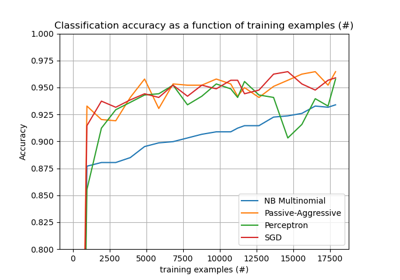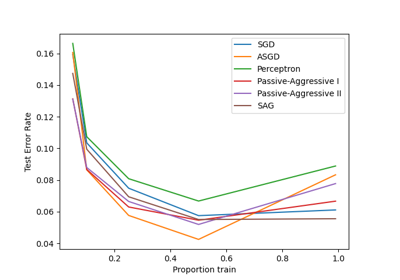-
class sklearn.linear_model.PassiveAggressiveClassifier(C=1.0, fit_intercept=True, n_iter=5, shuffle=True, verbose=0, loss='hinge', n_jobs=1, random_state=None, warm_start=False, class_weight=None)[source] -
Passive Aggressive Classifier
Read more in the User Guide.
Parameters: C : float
Maximum step size (regularization). Defaults to 1.0.
fit_intercept : bool, default=False
Whether the intercept should be estimated or not. If False, the data is assumed to be already centered.
n_iter : int, optional
The number of passes over the training data (aka epochs). Defaults to 5.
shuffle : bool, default=True
Whether or not the training data should be shuffled after each epoch.
random_state : int seed, RandomState instance, or None (default)
The seed of the pseudo random number generator to use when shuffling the data.
verbose : integer, optional
The verbosity level
n_jobs : integer, optional
The number of CPUs to use to do the OVA (One Versus All, for multi-class problems) computation. -1 means ?all CPUs?. Defaults to 1.
loss : string, optional
The loss function to be used: hinge: equivalent to PA-I in the reference paper. squared_hinge: equivalent to PA-II in the reference paper.
warm_start : bool, optional
When set to True, reuse the solution of the previous call to fit as initialization, otherwise, just erase the previous solution.
class_weight : dict, {class_label: weight} or ?balanced? or None, optional
Preset for the class_weight fit parameter.
Weights associated with classes. If not given, all classes are supposed to have weight one.
The ?balanced? mode uses the values of y to automatically adjust weights inversely proportional to class frequencies in the input data as
n_samples / (n_classes * np.bincount(y))New in version 0.17: parameter class_weight to automatically weight samples.
Attributes: coef_ : array, shape = [1, n_features] if n_classes == 2 else [n_classes, n_features]
Weights assigned to the features.
intercept_ : array, shape = [1] if n_classes == 2 else [n_classes]
Constants in decision function.
See also
References
Online Passive-Aggressive Algorithms <http://jmlr.csail.mit.edu/papers/volume7/crammer06a/crammer06a.pdf> K. Crammer, O. Dekel, J. Keshat, S. Shalev-Shwartz, Y. Singer - JMLR (2006)
Methods
decision_function(X)Predict confidence scores for samples. densify()Convert coefficient matrix to dense array format. fit(X, y[, coef_init, intercept_init])Fit linear model with Passive Aggressive algorithm. get_params([deep])Get parameters for this estimator. partial_fit(X, y[, classes])Fit linear model with Passive Aggressive algorithm. predict(X)Predict class labels for samples in X. score(X, y[, sample_weight])Returns the mean accuracy on the given test data and labels. set_params(\*args, \*\*kwargs)sparsify()Convert coefficient matrix to sparse format. -
__init__(C=1.0, fit_intercept=True, n_iter=5, shuffle=True, verbose=0, loss='hinge', n_jobs=1, random_state=None, warm_start=False, class_weight=None)[source]
-
decision_function(X)[source] -
Predict confidence scores for samples.
The confidence score for a sample is the signed distance of that sample to the hyperplane.
Parameters: X : {array-like, sparse matrix}, shape = (n_samples, n_features)
Samples.
Returns: array, shape=(n_samples,) if n_classes == 2 else (n_samples, n_classes) :
Confidence scores per (sample, class) combination. In the binary case, confidence score for self.classes_[1] where >0 means this class would be predicted.
-
densify()[source] -
Convert coefficient matrix to dense array format.
Converts the
coef_member (back) to a numpy.ndarray. This is the default format ofcoef_and is required for fitting, so calling this method is only required on models that have previously been sparsified; otherwise, it is a no-op.Returns: self: estimator :
-
fit(X, y, coef_init=None, intercept_init=None)[source] -
Fit linear model with Passive Aggressive algorithm.
Parameters: X : {array-like, sparse matrix}, shape = [n_samples, n_features]
Training data
y : numpy array of shape [n_samples]
Target values
coef_init : array, shape = [n_classes,n_features]
The initial coefficients to warm-start the optimization.
intercept_init : array, shape = [n_classes]
The initial intercept to warm-start the optimization.
Returns: self : returns an instance of self.
-
get_params(deep=True)[source] -
Get parameters for this estimator.
Parameters: deep : boolean, optional
If True, will return the parameters for this estimator and contained subobjects that are estimators.
Returns: params : mapping of string to any
Parameter names mapped to their values.
-
partial_fit(X, y, classes=None)[source] -
Fit linear model with Passive Aggressive algorithm.
Parameters: X : {array-like, sparse matrix}, shape = [n_samples, n_features]
Subset of the training data
y : numpy array of shape [n_samples]
Subset of the target values
classes : array, shape = [n_classes]
Classes across all calls to partial_fit. Can be obtained by via
np.unique(y_all), where y_all is the target vector of the entire dataset. This argument is required for the first call to partial_fit and can be omitted in the subsequent calls. Note that y doesn?t need to contain all labels inclasses.Returns: self : returns an instance of self.
-
predict(X)[source] -
Predict class labels for samples in X.
Parameters: X : {array-like, sparse matrix}, shape = [n_samples, n_features]
Samples.
Returns: C : array, shape = [n_samples]
Predicted class label per sample.
-
score(X, y, sample_weight=None)[source] -
Returns the mean accuracy on the given test data and labels.
In multi-label classification, this is the subset accuracy which is a harsh metric since you require for each sample that each label set be correctly predicted.
Parameters: X : array-like, shape = (n_samples, n_features)
Test samples.
y : array-like, shape = (n_samples) or (n_samples, n_outputs)
True labels for X.
sample_weight : array-like, shape = [n_samples], optional
Sample weights.
Returns: score : float
Mean accuracy of self.predict(X) wrt. y.
-
sparsify()[source] -
Convert coefficient matrix to sparse format.
Converts the
coef_member to a scipy.sparse matrix, which for L1-regularized models can be much more memory- and storage-efficient than the usual numpy.ndarray representation.The
intercept_member is not converted.Returns: self: estimator : Notes
For non-sparse models, i.e. when there are not many zeros in
coef_, this may actually increase memory usage, so use this method with care. A rule of thumb is that the number of zero elements, which can be computed with(coef_ == 0).sum(), must be more than 50% for this to provide significant benefits.After calling this method, further fitting with the partial_fit method (if any) will not work until you call densify.
-
linear_model.PassiveAggressiveClassifier()
Examples using
2025-01-10 15:47:30



Please login to continue.